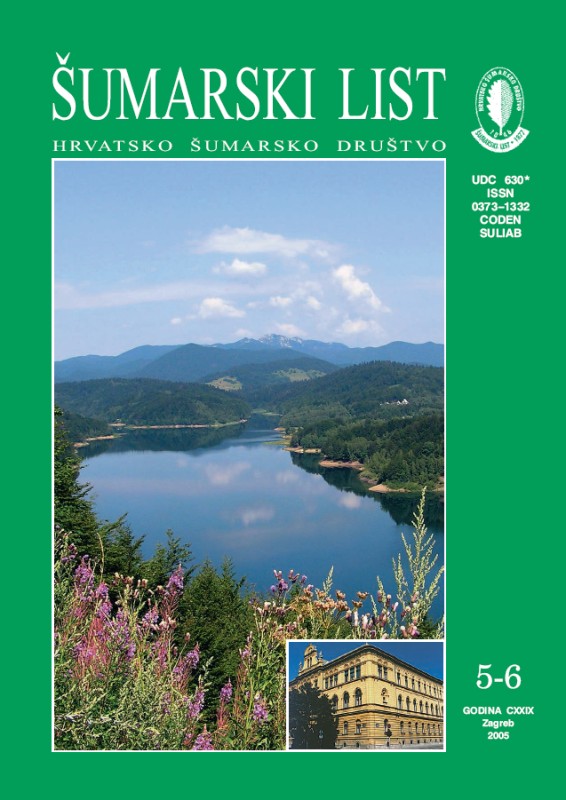
broj: 5-6/2005
pdf (29,9 MB) |
|
||||||||||||||
| IZVORNI ZNANSTVENI ČLANCI | ||
| Orlić, S., S. Perić | UDK 630* 232.1 (001) | |
| Study of Growth of Douglas Fir Provenances (Pseudotsuga menziesii (Mirb.) Franco) on Krndija pdf HR EN | 243 | |
| Križanec, R. | UDK 630* 228 + 561 (001) | |
| Transition Time as an Indicator of Changes in the Development of Forest Stands of Selection Silvicultural Form pdf HR EN | 251 | |
| Pernek, M., I. Pilaš | UDK 630* 453 (001) | |
| Gradations of Gypsy Moth - Lymantria dispar L. (Lep., Lymantriidae) in Croatia pdf HR EN | 263 | |
| PRETHODNO PRIOPĆENJE | ||
| Kajba, D., I. Anić, D. Pfeifer | UDK 630* 165 (Populus nigra L.) | |
| Sustainability and Conservation of Genetic Resources with a Focus on the European Black Poplar (Populus Nigra L.) pdf HR EN | 271 | |
| Summary: This article presents and explains the conclusions made by the Croatian Poplar Commission at the Ministry of Agriculture, Forestry and Water Management, after the discussions on problems of riparian forests sustainability, poplar forest stands management, regeneration methods and possibilities and methods of genetic resources conservation, on the example of European Black Poplar (Populus nigra L.). Regeneration of European Black Poplar populations is a very important task for forest management, especially in areas where the riparian sites and their eco-systems are endangered. Renewed or conserved poplar populations present an important contribution in conservation of complex eco-system of riparian forests. Strategy for genetic resources conservation of domestic poplars can be divided in three operative goals: 1. ensure optimal quantity of regeneration, 2. prevent loss of genetic diversity and individual fitness at generation turn-over, 3. identify and preserve local or regional gene pools, if existing. It is necessary to intensify selection, breeding and testing of domestic black poplar clones, to acquire high quality plant material for riparian forest stands regeneration. Also crucial is the selection of plus variants from natural juvenile European Black Poplar populations, since in this manner it’s possible to select new genotypes, well adapted to specific local sites. Regeneration strategy should be guided by the principle of replacing the plantations of Euroamerican Poplars with European Black Poplar, all in accordance to forest silvicultural plans. The sites in whitch the water regime allows continuous regenerations of Poplars, appropriate methods of renewall and activity dynamics should be predicted and established by these plans. For fulfilling the goal of total stand replacement, a period of at least 50 years should be predicted. In the meantime, forest production of Euroamerican poplar (P. × canadensis) should continue on approx. 25 % of total surfaces. Key words: sustainability; riparian forests; Populus nigra L.; Croatian Poplar Commission | ||
| PREGLEDNI ČLANCI | ||
| Meštrić, B. | UDK 630* 945.1 | |
| Forestry Journal - Bibliographic Database and Its Presentation pdf HR EN | 279 | |
| Šporčić, M. | UDK 630* 641 | |
| Insight Into Some Aspects of Entrepreneurship in the European Forestry pdf HR EN | 287 | |


